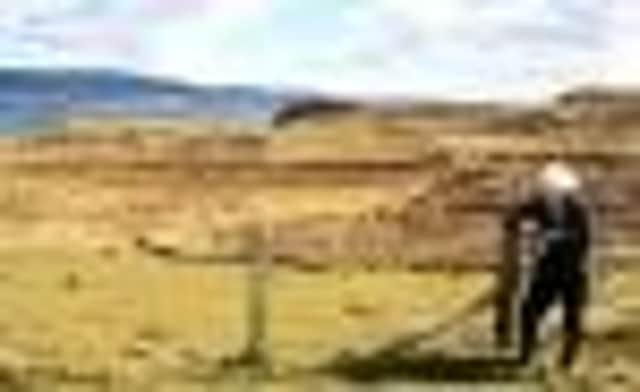Scotland’s croft lands to be mapped for posterity


The massive project to chart over three quarter of a million hectares of land in the highlands and islands is aimed at protecting the crofting way of life and stopping landowners, offshore trusts, prospective buyers and councils from laying claim to “ransom strips” whose ownership is not legally registered.
Crofting leaders say previous cases in which croft lands have been lost included the building of an entire housing estate in Shetland and a pier on the island of Coll. Because there is no exact record of croft lands, large swathes of are at risk, the Scottish Crofting Federation (SCF) fears.
Advertisement
Hide AdEarlier this month, Donald Murdie, of Galtrigill on Skye, got the project in motion by becoming the first crofter to map his land and put it on the Crofting Register, held by the Registers of Scotland.
According to the SCF, there are now a further 18,026 crofts to be mapped, an undertaking which could take many years.
Drawing up crofting maps involves sources ranging from historical estate maps, Ordnance Survey maps, letters and Google Earth.
Crofters will have to have a map registered before they can do any transactions with the Crofting Commission, the Scottish Government’s crofting regulatory agency.
Murdie, 62,who been a crofter for 25 years, said: “I decided that because sooner or later we’re all going to have to do it I’d have a wee experiment with it and then got so far and thought: ‘Oh well, I may as well submit it.’
“The Register of Scotland website has all the instructions, but it is not straightforward in that it’s a 29 megabyte download and a lot of crofters don’t have broadband, if they’ve got internet at all.”
Advertisement
Hide AdMurdie, who lives on his croft with his wife Susanna, said he got help from the Scottish Agricultural College to help draw his boundaries, using their mapping software.
“I found the actual application straightforward enough once I got the instructions, but even in this small 14-acre croft there were nine people with interests in adjacent land.
Advertisement
Hide Ad“Some crofters don’t know who their landlords are – they might be absent, or they’ve never seen them, or they’re based in Andorra or the Seychelles, and there is no way of finding out who it is.
“It is important to draw boundaries right up to the road or the shore and not leave any opportunities for people to claim ransom strips.
“If there had been this kind of map-based register in the past, far less land would have been lost.”
Crofters believe the maps will give them more influence over their future and authority in arguing their case with landlords and other bodies. It will also allow them to expand into income-generating projects such as renewable energy and forestry.
Derek Flyn, chair of the SCF, said: “I congratulate Donald because we are fully behind the idea of mapping all croft lands so it isn’t lost to future generations.
“We are speaking to crofting communities to encourage community mapping because there’s less likelihood of land being lost. The fear is that if land is not identified as croft land or community grazing it will fall out of crofting use.
Advertisement
Hide Ad“It’s hardly the sign of a mature system that we don’t know the boundaries of the land we occupy. We’ve seen people buy estates and take over ‘ransom strips’, remnants of land which are not mapped, and then the land is lost.”
Seori Burnett, 52, is a crofter involved in producing a community-wide croft map in the township of Badrallach, near Ullapool in Wester Ross. Burnett, who lives with his wife three children on his ten-acre croft, said: “We notified everyone we were having a meeting and invited everyone to send maps in. This could be anything from historical maps to old estate maps.
Advertisement
Hide Ad“About a dozen of us met in a bothy and had a brain-storming session,” he said. “Some things were unclear and had to be resolved and some anomalies came to light.
“The ownership of a map gives you influence and empowerment meaning you can make decisions,” said Burnett.
James Hunter, emeritus professor of history at the University of the Highlands and Islands and author of 12 books on the Highlands, welcomed the mapping project move, but said more action was needed to uncover the identity of those who owned large parts of Scotland.
“It’s a step forward in all sorts of ways,” he said. “But it’s a bit ironic that all this effort is going into mapping croft boundaries, even small two- or three-acre crofts, yet you will probably not be able to find out who owns a 50,000-acre estate.”